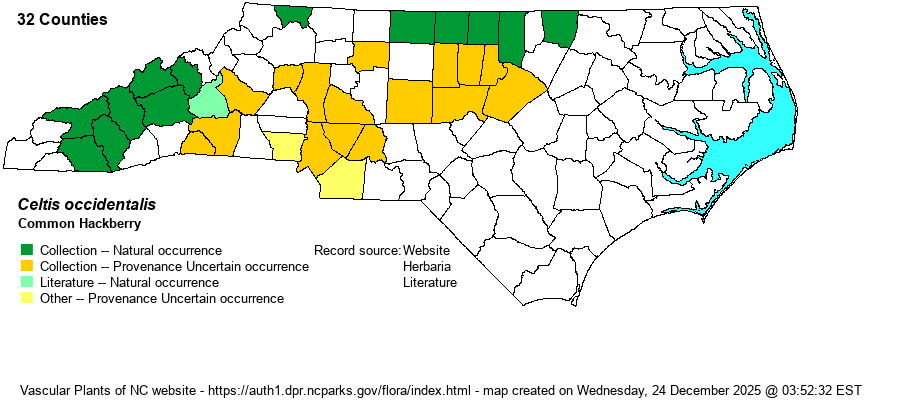| Author | L. | |
| Distribution | Scattered over much of the Mountains and Piedmont. Generally absent over all of the Coastal Plain, even though it ranges south in VA close to much of the border of these two provinces. However, this species escapes readily, and it may be that its natural distribution in the state is primarily the Mountains and rarely into the northern Piedmont (as on the RAB [1968] map and on the BONAP map). In addition, some or many of the Piedmont specimens might be that of C. pumila, which is quite similar. Thus, the status of this tree species in the Piedmont is quite unsettled.
This is a wide-ranging Northern and Midwestern species. It occurs from Canada south to SC, GA, and TX, but is very scarce south of VA. | |
| Abundance | Generally rare to locally uncommon in the Mountains, and rare farther eastward, where many (if not most) locations might not be natural. This is an NC Watch List species. | |
| Habitat | This species is a near strict “mafic” species, found almost always in high pH soils. However, it can be found on bluffs, rocky slopes, river banks, and bottomlands. In the Mountains of NC, most records are from rocky woods and slopes/bluffs, but over mafic/calcareous rocks. |
| Phenology | Flowers from March to May; fruits from August to October. | |
| Identification | This is a familiar tree to our North and Northwest, but it is not familiar to most biologists in the state. It is a small to medium deciduous tree, mostly growing to 40-50 feet tall. As with Celtis laevigata, the gray bark is heavily adorned with numerous warty projections, making it readily identifiable as a hackberry species. It has alternate, ovate to somewhat lanceolate leaves with some serrations along the margins, growing to about 3-3.5 inches long. These leaves are wider than those of the quite lanceolate leaves of C. laevigata of rich bottomlands and riverbanks. Also, the leaves are paler below than above, whereas C. laevigata leaves are quite green below. The much smaller C. pumila is quite similar to C. occidentalis and must be separated with care. See that species for identification. | |
| Taxonomic Comments | This species has no taxonomic issues as a valid species. However, many references in the past included C. pumila within it, as C. occidentalis var. georgiana (e.g., RAB 1968). Such references thus had this species listed as C. occidentalis var. occidentalis.
| |
| Other Common Name(s) | Hackberry, Northern Hackberry, American Hackberry
| |
| State Rank | S2 [S2?] | |
| Global Rank | G5 | |
| State Status | W7 | |
| US Status | | |
| USACE-agcp | FACU link |
| USACE-emp | FACU link |

